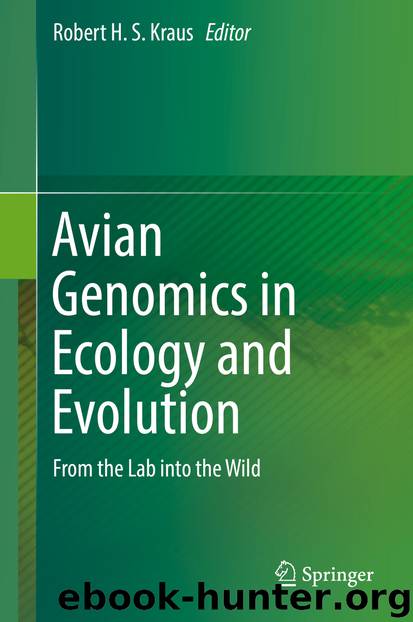Avian Genomics in Ecology and Evolution by Robert H. S. Kraus

Author:Robert H. S. Kraus
Language: eng
Format: epub
ISBN: 9783030164775
Publisher: Springer International Publishing
Mixtures of Gene Trees That Reflect Heterotachy, Incomplete Lineage Sorting, or Reticulation
Another challenge for phylogenomic studies is the fact that genomic data may reflect a mixture of trees rather than a single tree (Maddison 1997). The simplest case is a mixture of trees with the same topology but different branch lengths (Fig. 6d), a phenomenon also called heterotachy (Lopez et al. 2002). Heterotachy in protein-coding regions is often thought to reflect shifts in selective constraints, causing sites to transition between a state in which substitutions can accumulate, and a second state in which substitutions are removed by purifying selection (Penny et al. 2001). However, regional variation in mutation rates is well characterized in birds (e.g., Axelsson et al. 2005), and shifts in the mutation rate for a specific neutral region will also result in heterotachy. Regardless of the biological basis for heterotachy, analyses of heterotachous data using standard (i.e., non-heterotachous) ML methods can be misleading (Matsen and Steel 2007), sometimes resulting in a “mixed branch repulsion” analogous to long-branch attraction. A more extreme tree mixture involves gene trees with different topologies (Fig. 6e). Those tree mixtures are biologically realistic; a number of processes, such as incomplete lineage sorting (ILS) and hybridization, can result in mixtures of trees with different topologies (Maddison 1997). Edwards (2009) pointed out that ILS actually results in both heterotachy and discordant trees; the heterotachy reflects variation in coalescence times for gene trees with the same topology. In fact, some gene trees with the same topology as the species tree still reflect a deep coalescence (DC) in which the split in the gene tree occurs prior to multiple speciation events (e.g., the gray gene tree in Fig. 6e); branch lengths of those trees will certainly differ from the non-DC trees. Mixtures with multiple topologies arise when DC gene trees are discordant with the species tree (e.g., the dashed gene tree in Fig. 6e). There is strong direct evidence for heterotachy (e.g., note the very different terminal branch lengths for BDNF and PPP2CB in Fig. 8), although the impact of heterotachy on estimates of avian phylogeny using standard ML methods remains unclear. The evidence for discordance among gene trees due to ILS is indirect, but there is a strong theoretical basis for expecting ILS whenever there are short branches in a species tree. The impact of ILS on estimates of the bird tree obtained using standard ML methods also remains uncertain.
Fig. 8Two examples of gene trees from Reddy et al. (2017), emphasizing differences in relative rates and base composition. Support values from an ultrafast bootstrap (Minh et al. 2013) analysis in IQ-TREE are shown next to branches when they are ≥70%. (a) Tree based on an intron in the PPP2CB locus. This is one of the few individual gene trees that divides Neoaves into Columbea and Passerea. As in Fig. 7, the GC-content for informative sites is indicated with colored arrows (red for the six most GC-rich taxa and blue for the six least GC-rich taxa). Although the median GC-content for informative sites (45.
Download
This site does not store any files on its server. We only index and link to content provided by other sites. Please contact the content providers to delete copyright contents if any and email us, we'll remove relevant links or contents immediately.
| Anatomy | Animals |
| Bacteriology | Biochemistry |
| Bioelectricity | Bioinformatics |
| Biology | Biophysics |
| Biotechnology | Botany |
| Ecology | Genetics |
| Paleontology | Plants |
| Taxonomic Classification | Zoology |
Sapiens: A Brief History of Humankind by Yuval Noah Harari(14155)
The Tidewater Tales by John Barth(12568)
Mastermind: How to Think Like Sherlock Holmes by Maria Konnikova(7156)
Do No Harm Stories of Life, Death and Brain Surgery by Henry Marsh(6835)
The Thirst by Nesbo Jo(6752)
Why We Sleep: Unlocking the Power of Sleep and Dreams by Matthew Walker(6550)
Life 3.0: Being Human in the Age of Artificial Intelligence by Tegmark Max(5402)
Sapiens by Yuval Noah Harari(5259)
The Longevity Diet by Valter Longo(4990)
The Body: A Guide for Occupants by Bill Bryson(4877)
The Rules Do Not Apply by Ariel Levy(4785)
The Immortal Life of Henrietta Lacks by Rebecca Skloot(4445)
Animal Frequency by Melissa Alvarez(4362)
Why We Sleep by Matthew Walker(4312)
The Hacking of the American Mind by Robert H. Lustig(4263)
Yoga Anatomy by Kaminoff Leslie(4244)
All Creatures Great and Small by James Herriot(4187)
Double Down (Diary of a Wimpy Kid Book 11) by Jeff Kinney(4134)
Barron's AP Biology by Goldberg M.S. Deborah T(4061)
